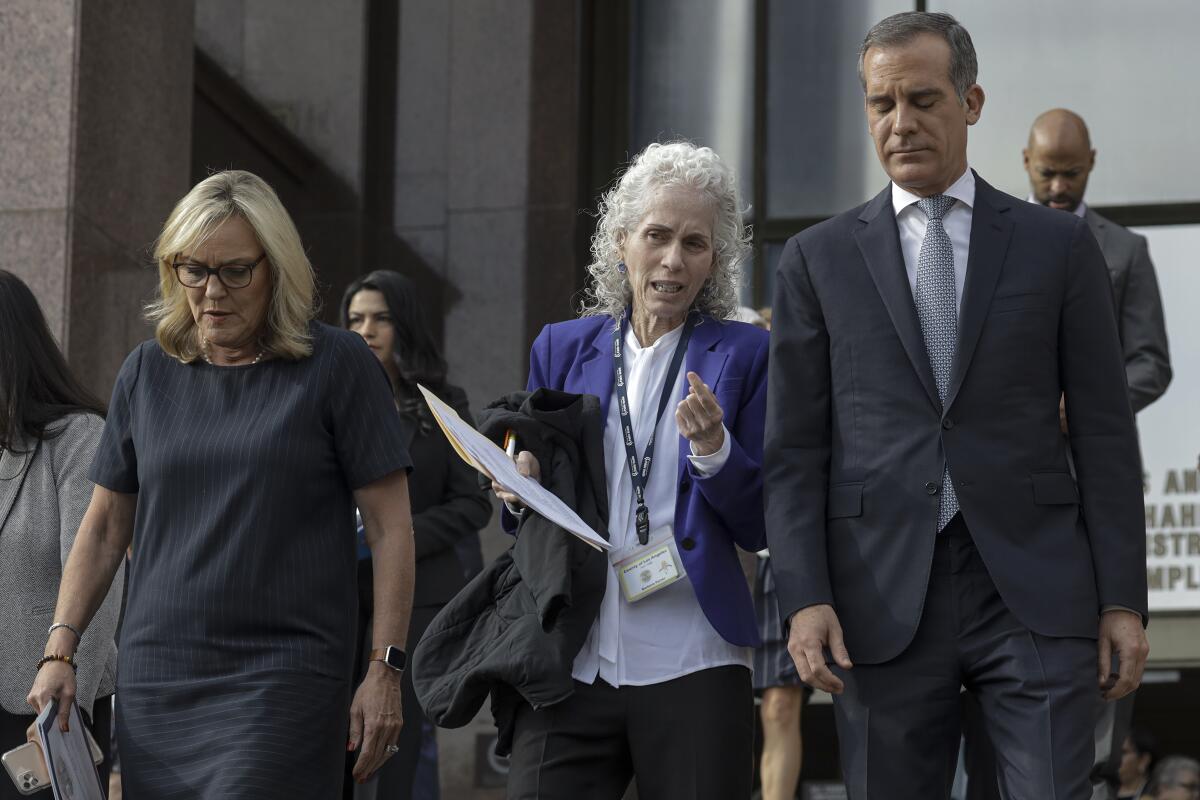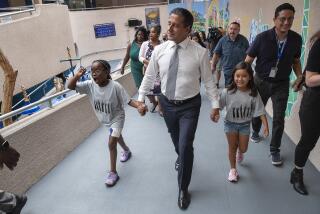Schools in L.A. County can reopen for up to 25% of their students who need special services

- Share via
In a significant move to bring more students back to campus, Los Angeles County schools will be permitted to bring 25% of their students back to campus at a time, provided that they need special services best offered in person.
Students receiving priority would include those learning English and those with disabilities
The action announced Wednesday by Supervisor Kathryn Barger comes in response to pressure to allow more students on campus and reports that schools elsewhere have reopened with relative safety during the coronavirus pandemic.
“We will now increase to 25% capacity for high-needs students, so more children and youth can have access to their teachers and on-site support systems that are so critical for their growth and education,” Barger said. The protocol for that expansion will likely be released next week, she said.
The county’s announcement comes as evidence mounts that students are faring poorly in online learning — and as district officials and teachers are working to improve it.
Three in four parents of students with disabilities in the L.A. Unified School District say their children are making inadequate progress this fall with campuses closed and are backsliding on emotional and academic skills because of a dearth of needed and legally required services, according to a survey of 300 parents released Wednesday.
Los Angeles schools officials and the teachers union, United Teachers Los Angeles, are bargaining over what classroom conditions will look like when students return, but neither has pressed publicly to do so in the short term. Teacher unions up and down the state have urged caution in reopening. UTLA and L.A. school officials have negotiated voluntary in-person tutoring, typically conducted outside with masks and social distancing.
Union leaders have said it’s not yet safe to bring back significant numbers of staff and students because L.A. County falls in the state’s purple tier, signifying widespread virus transmission, the worst category. Schools cannot generally reopen until a county has been in the next or red tier for at least two weeks. Such a designation is at least several weeks away, leaving many parents frustrated as they observe schools reopening in Ventura, Orange and San Diego counties.
The state does allow some exceptions, including bringing back small groups with special needs. State rules permit schools to operate at 25% capacity. The county had stuck with a stricter 10% standard until Wednesday. Elementary schools also can open under a waiver up through Grade 2, and L.A. County posted its first four approvals Wednesday, all for private schools.
L.A. schools Supt. Austin Beutner has advocated a go-slow approach, often speaking in terms similar to the teachers union. The in-person tutoring, which began Oct. 5, requires all participants to submit a negative coronavirus test.
“We’re going to see how that goes,” Beutner said last week. “If that goes well, we’re going to build it.”
The survey, conducted by the advocacy group Speak Up, suggests that in the meantime, most students with disabilities are regressing.
In the survey, 76% of parents said their children with disabilities cannot learn effectively via distance learning, and a similar number, 74% reported regressive behaviors in their children.
“These behaviors included signs of learning loss, such as a first-grader who is forgetting the alphabet, as well as behavioral issues, including meltdowns, injury to themselves or their parents, and falling behind on behavioral goals that had previously been met,” according to Speak Up.
The results are based on responses that were collected from Sept. 23 through Oct. 20. While not a scientific poll, the online survey reflects input from across the vast school system. Other polls — statewide and national — have revealed broad dissatisfaction with distance learning but have not necessarily focused on students with disabilities.
“The vast majority of kids with disabilities are not being well-served during campus closures and are unable to learn effectively through distance learning,” said Katie Braude, the chief executive officer of Speak Up. “The regression and learning loss of our kids threatens to leave our most vulnerable students far behind.”
More than a third of parents said their children are not receiving the full set of services that L.A. Unified had previously agreed to deliver in legally binding compliance documents.
Parent Carla Suarez-Capdet said her kindergarten son needs in-person specialized attention, but that the district would not authorize an outside provider to enter her home. The district recently offered three 30-minute sessions of on-campus tutoring per week, but not necessarily with a tutor with the appropriate experience.
But faced with one Zoom session after another, her son started lashing out, kicking and hitting.
All the same, Suarez-Capdet praises her child’s speech pathologist and occupational therapist for making “phenomenal” efforts to provide services online.
Speak Up accuses the district of doing too little and the teachers union of setting up obstacles to student services.
But teacher Lynn Marie Mierzejewski said it remains important to prioritize safety for all and said she’s willing to work harder to make sure her students don’t lose out.
Mierzejewski said it takes two-and-a-half to three extra hours a night to prepare lessons that will be engaging for her autistic students, in grades three through five at Harmony Elementary in South Los Angeles.
“It does not matter how many extra hours I have to put in,” said Mierzejewski, who is among thousands of teachers who’ve taken additional training to master online skills.
A senior district official, regional Supt. Mike Romero of the South area, said Wednesday that more help is on the way. The district is ramping up paid online tutoring that is expected to reach every school.
The in-person tutoring also is growing, he added. So far about one-third of the schools in his region are offering it. Across the school system, which has about 460,000 students, about 500 teachers (with about 200 paraprofessionals in support) are working with about 1,000 students.
Romero said everyone knows that more must be done and the district is trying every day to make progress.
“We’re not where we need to be,” Romero said. But “We have heroic efforts. ... We’re moving quickly.”
More to Read
Sign up for Essential California
The most important California stories and recommendations in your inbox every morning.
You may occasionally receive promotional content from the Los Angeles Times.












